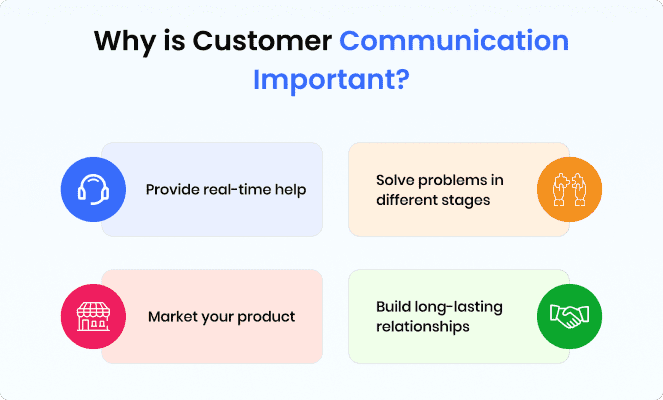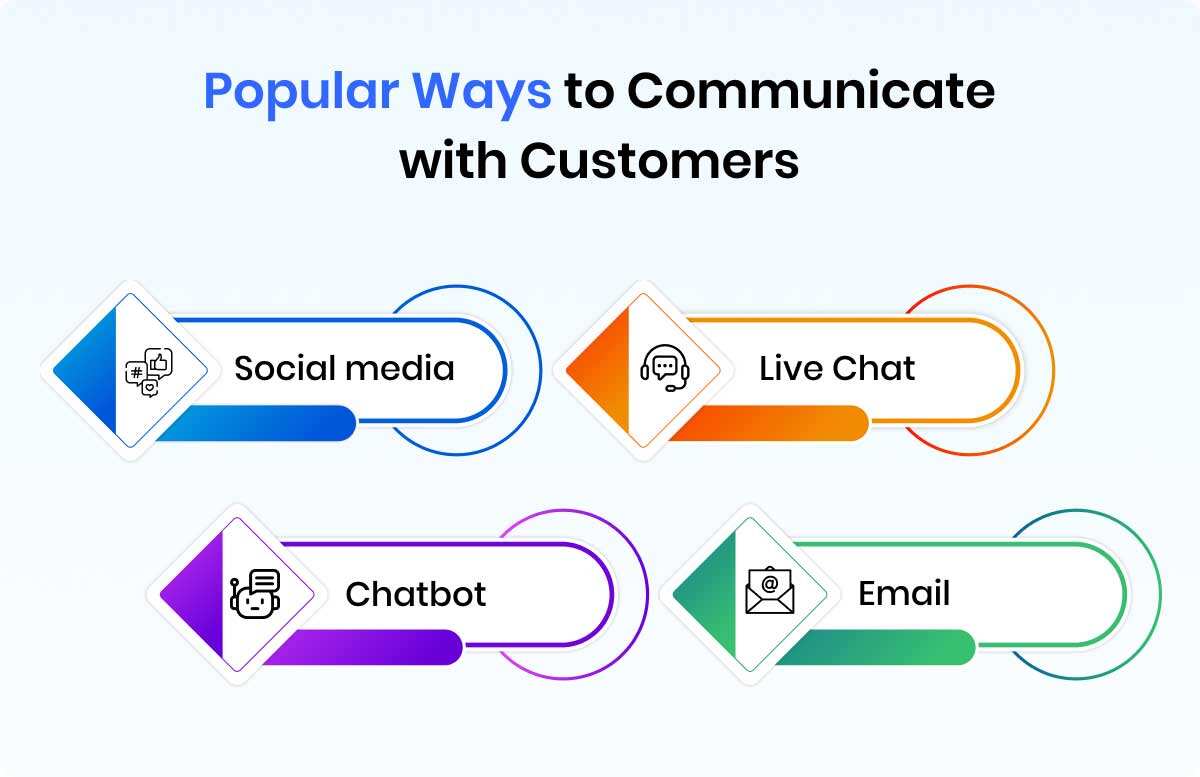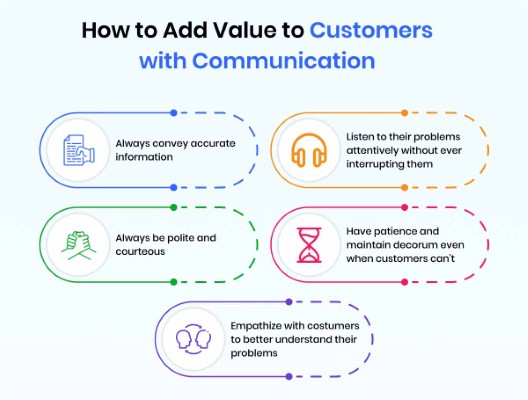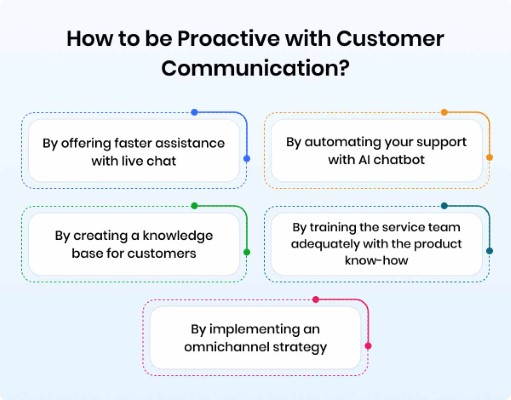How to Communicate with Customers – Tips, Tools & Strategies
- December 14, 2022
- 12 mins read
- Listen

Table of Content
Here is a very familiar script that most businesses can relate to at some level. And it goes something like this –
You believe you have a good product. And you also believe you have a great support team in place. So, you’re obviously confident that your product would be a hit with customers who will fall over themselves to grab it.
You, however, notice that something is not adding up. You realize that things are somehow not falling into places the way you’d expected. In fact, you can see customers not lapping up your product as you hoped and some of them are even leaving you.
What may be going wrong, you secretly wonder?
Well, most probably something must be wrong with the way you communicate with customers. After all, 90% of customers spend more with a brand that provides them good service. They would not be doing the same if communication was poor.
Yeah, customer communication is a way more important business aspect than we assume, and it has the potential to make or break your brand.
In this blog, we will discuss how to communicate with customers effectively and dwell on some tips and strategies for communication.
Why is Customer Communication Important?
Communication is often the building block of a great customer relationship. It’s an art to engage people and get their attention so that they can grasp your message. And when you have the attention of the audience, the sky is the limit. On the other hand, a good product too would go useless if you or your team did not communicate well with users.
There are many reasons why customer communication is important for any business.
- Provide real-time help – One of the key goals of communication is to be available where and when customers expect you and then help them in real time. Doing this can give value to your customers who might feel encouraged to do business with you.
- Solve problems in different stages – Customers expect quick solutions to any problem they face with your product or service. And communication is a tool that can help you solve problems in different stages of the customer journey.
- Market your product – Brands that know how to communicate well with customers often witness positives to key metrics be it marketing, sales, or conversion. If you know how and when to open the conversations, you’re likely to have more happy and more loyal customers than others.
- Build long-lasting relationships – The purpose of communication often goes beyond solving problems or marketing products. Many companies successfully leverage its huge potential to build rewarding long-term relationships with their customers.
Popular Ways to Communicate with Customers
Your customers are smart. You just can’t take them for a ride. And if you did, they would ditch the ride and hop onto someone else’s. After all, choices are plenty in front of them and it’s you who needs to keep pace with them, not the other way around. And when it comes to communication channels and strategies, make sure you use the ways they prefer, not the other way around.
Some of the popular ways to communicate with customers are –
- Social media – Social platforms are where most of your customers often hang out. And they not only hang out, but they also expect everything to be served there itself. So, right from updating them to sharing new information to opening a conversation with them, make sure your social channel strategy is up and running for communication.
- Live Chat – Not all your customers would take the traditional route and approach the support team first via phone. Most of them now prefer live chat as it’s quick, convenient, and real-time. Plus, it saves them wait time as well. Make sure you have a live chat installed on the website or social media pages to cater to an eager audience.
- Chatbot – Automation is the need of modern times. And its utility feels even more when you receive hundreds of customer queries on a daily basis. All you need is just an Ai-powered bot deployed on your website or app or social pages and then you can always be available for customers on a 24×7 basis.
- Email – Yes, they are not dead. They are very much alive and well, kicking. And when it comes to long and meaningful customer conversations, emails are still way ahead in pecking order simply for bringing that personalized touch and professional appeal customers often vouch for.
How to Communicate Effectively With Customers
Customer communication is not rocket science. It’s just a genuine effort on your part to engage with people who may have some problems and then help them through different stages of the journey with your brand. And if you could help them timely, it means you have communicated well with them. That’s all!
There are some tips you can learn and understand on how to communicate effectively with your customers.
1. Look to Add Value to Customers
Customer communication should be seen and approached as an opportunity to serve customers. It should be used as a tool to add value rather than just solve problems.
More importantly, when a customer approaches your business, your purpose should always be long-term in mind rather than momentary.
Adding value to customers can take various forms, including –
- Always convey accurate information
- Adopt a customer-centric approach
- Listen to their problems attentively without ever interrupting them
- Always be polite and courteous
- Have patience and maintain decorum even when customers can’t
- Empathize with customers to better understand their problems
2. Identity Your Customers Needs First
Customers don’t come to you waiting for the sky. They rather have a need that brings them to you. And all you need is to identify the need and then help around that. When you meet the exact needs and expectations of the customers, you have done your job. This is the real purpose of communication.
Identifying customer needs means researching what your customers want and then expanding your product features or services to meet those needs. It’s also about taking steps to deliver them a better experience and exceed their expectations
Types of customer needs
- Product Needs
- Service Needs
When the need is related to the product, it means your communication is going to focus on factors like price, features, utility, value addition, and effectiveness.
On the other hand, when the need is related to the service, it means they will seek information, and clarity and expect empathy. Here, the focus of communication should be more on the emotional side.
3. Be Proactive
When you want to communicate with customers, there are basically two approaches –
- Either you wait for customers to reach you with their problems
- Or you take steps to reach out to them and solve their problems
So, where do you stand? What strategy do you follow?
Before answering this question, you should better know how most customers now expect companies to reach out to them. They also expect companies to make the first move and go the extra mile for them.
And when you are proactive, it means –
- You care for customers and you want to communicate well with them
- You want to resolve their issues promptly and ensure a great experience with your brand
But the question is, how could you be proactive with customer communication? Well, in various ways, including –
- By offering faster assistance with live chat or by automating your support with an AI chatbot
- By creating a knowledge base for customers
- By training the service team adequately with the product know-how
- By implementing an omnichannel strategy so that you could customers as and where they want
4. Use Advanced Engagement Tools
Being flexible is often one key aspect of customer communication. It means you need to be open to the idea of starting a conversation on any channel that customers prefer. And if you’re rigid, it could hugely impact the quality of communication for sure.
And you can never be flexible unless you have the right kind of engagement tools. They give you the leverage you need to make customer conversations rewarding and enriching. And due to those tools, your support team could find more power to approach customer issues with confidence.
For example, using live chat could be a bad communication strategy with a set of customers who are more interested in exploring things on their own. For them, you need a chatbot that can automate FAQs so that everyday queries could be handled effortlessly.
Similarly, sometimes your customers may want a touch of personalization, and video chat software could be ideal for those situations. Likewise, you could be better off using co-browsing software when there is something you want to explore ( or browse ) together with customers for offering better guidance and help.
The best part, using engagement tools can also give you an idea about how did the staff communicate with customers and whether they delivered value. More so, the focus should be on adopting an integrated marketing communication approach to maintain consistency in messaging.
5. Resolve Issues Quickly
Customers simply hate waiting. Don’t make them wait longer than they would like. Even a one-minute wait time feels long, at least to 60% of respondents to this survey.
The more you make them wait for responses, the more likely are they to feel frustrated, which in turn, is more likely to push them out of your grasp and into the net of competitors.
So, if responding quickly to queries is not your priority, you then be better prepared to lose customers.
Quick response is often a pillar of effective customer communication. Being quick can solve a variety of communication problems. It also brings benefits galore, including –
- It shows you care for customers
- It shows your support team is professional
- It shows your team is attentive and forever ready for customers
A good example of resolving issues quickly is – you make sure you have responded to a chat message within 2 minutes, or else it would be late. This kind of response time is also expected for social channel queries.
Whether a customer approaches you via phone or live chat, using a routing feature could drastically bring down the wait time and enhance the overall experience as well.
In general, an email response should never take more than a day as anything beyond that is considered a delay.
6. Personalize the Interactions
For you, each customer should be unique, and so does the experience you provide them. It is a wrong tactic to tar them all with the same brush when you know how customers crave to feel special.
And yes, 70% of customers feel frustrated when the shopping experience is not personalized.
So how could you make customers feel special?
Personalization could help as it is a strategy to adopt an individualized approach to communicating with customers.
The more you personalize customer communication, the more positive impact it will bring to your business. It can result in happier customers, improved brand loyalty, superior CLV, and better conversions.
When it comes to adopting personalization, you need to make sure –
- You leverage customer-centric data so that agents could decipher targeted and contextual conversations and deliver personalized responses.
- You collect and keep all the customer data in one dashboard as it can help in quick insights and personalized service.
- Using top customer service tools can ensure real-time engagement which is good for offering a personal touch to various forms of customer communication.
7. Have a Trained Team in Place
Customer communication takes a serious hit when the service team is not trained. It can hugely dilute the experience that customers otherwise expect from your business.
More so, when the team lacks skills and experience in handling customers, its effects often percolate down to other aspects of the business as well.
And when we say a trained team, it means –
- Your team should have complete product knowledge
- Your team should be well-versed in communication
- Your team should have a positive mindset for serving customers
- Your team should be aware of the best way to communicate with customers
Having a trained team means your support people have the experience to handle any situation effectively, including system outages. In fact, your team should be skilled enough to know how to communicate with customers during an outage.
Power Your Customer Communication with REVE’s Engagement Tools
Customers deserve a good experience when they engage with your business. And the path to a good experience goes through effective communication.
We, at REVE Chat, realize the huge value that communication can have on the button line of a business and therefore we always strive to contribute to this aspect.
You can use our whole range of engagement tools including AI-powered chatbots to create a difference in the way you interact with customers.
Apart from the chatbot, we also have video chat and co-browsing software for making communication more personalized in nature.
Plus, you can always combine our live chat and bot together to deliver a hybrid experience to customers.
Using our advanced tools, you can find innovative ways to communicate with customers smoothly and assist them easily through different stages of the journey.
Prepare Your Business for Communication Challenges with the REVE Platform
Losing customers is always a possibility when your business does not have a proper communication strategy in place. And when you don’t have the right tools at your disposal, your support team feels hamstrung to the channels of conversations.
With the REVE Chat platform, you could effortlessly transform your communication strategy and take the right steps to add value to customers. The platform will help you communicate with customers as easily as it should.
You can start a free trial of our tools and see how and where they fit into your new-age communication approach.







